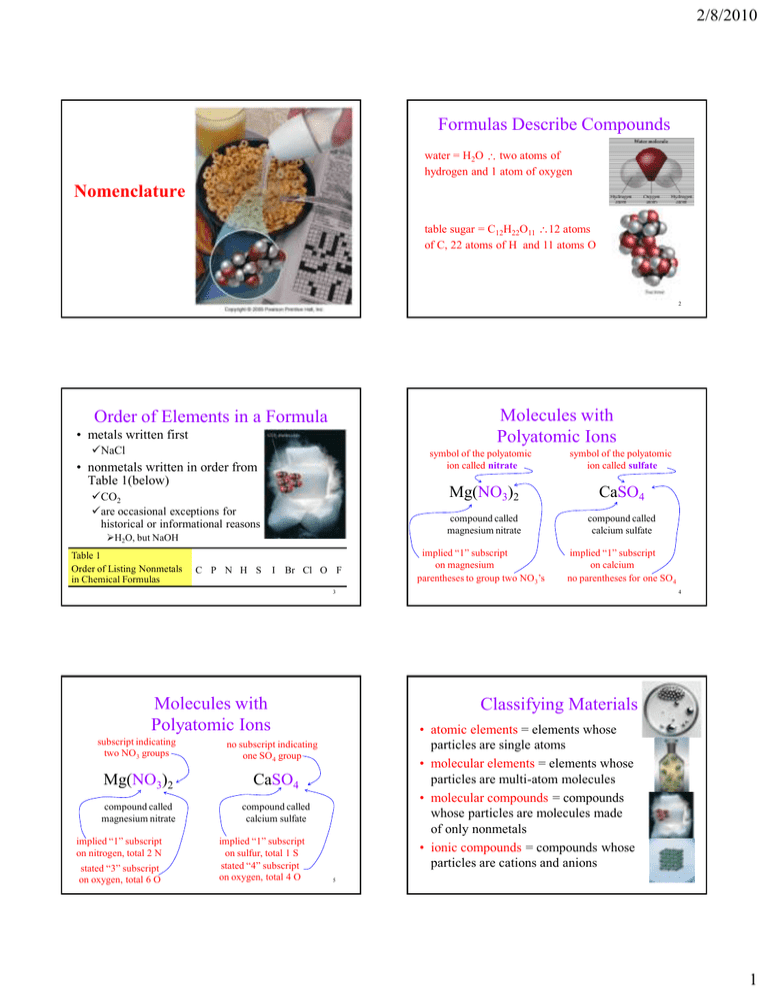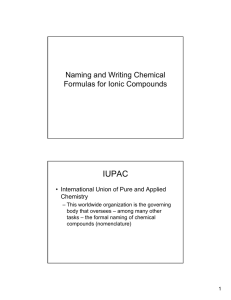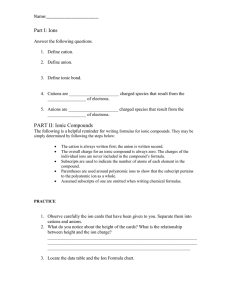Nomenclature Formulas Describe Compounds 2/8/2010
advertisement

2/8/2010 Formulas Describe Compounds water = H2O two atoms of hydrogen and 1 atom of oxygen Nomenclature table sugar = C12H22O11 12 atoms of C, 22 atoms of H and 11 atoms O 2 Molecules with Polyatomic Ions Order of Elements in a Formula • metals written first NaCl symbol of the polyatomic ion called nitrate • nonmetals written in order from Table 1(below) CO2 are occasional exceptions for historical or informational reasons H2O, but NaOH Table 1 Order of Listing Nonmetals in Chemical Formulas C P N H S I Br Cl O F symbol of the polyatomic ion called sulfate Mg(NO3)2 CaSO4 compound called magnesium nitrate compound called calcium sulfate implied “1” subscript on magnesium parentheses to group two NO3’s implied “1” subscript on calcium no parentheses for one SO4 3 Molecules with Polyatomic Ions subscript indicating two NO3 groups CaSO4 compound called magnesium nitrate compound called calcium sulfate implied “1” subscript on nitrogen, total 2 N stated “3” subscript on oxygen, total 6 O Classifying Materials • atomic elements = elements whose particles are single atoms • molecular elements = elements whose particles are multi-atom molecules • molecular compounds = compounds whose particles are molecules made of only nonmetals • ionic compounds = compounds whose particles are cations and anions no subscript indicating one SO4 group Mg(NO3)2 implied “1” subscript on sulfur, total 1 S stated “4” subscript on oxygen, total 4 O 4 5 6 1 2/8/2010 Molecular Elements • Certain elements occur as 2 atom molecules • Rule of 7’s Molecular Compounds there are 7 common diatomic elements find the element with atomic number 7, N make a figure 7 by going over to Group 7A, then down don’t forget to include H2 VIIA H2 N2 7 P4 O2 F2 S8 Cl2 • two or more nonmetals • smallest unit is a molecule Br2 I2 7 8 Molecular View of Elements and Compounds Ionic Compounds • metals + nonmetals • no individual molecule units, instead have a 3-dimensional array of cations and anions made of formula units 9 Classify each of the following as either an atomic element, molecular element, molecular compound or ionic compound • aluminum, Al • aluminum chloride, AlCl3 • chlorine, Cl2 • acetone, C3H6O • carbon monoxide, CO • cobalt, Co 11 10 Classify each of the following as either an atomic element, molecular element, molecular compound or ionic compound • aluminum, Al = atomic element • aluminum chloride, AlCl3 = ionic compound • chlorine, Cl2 = molecular element • acetone, C3H6O = molecular compound • carbon monoxide, CO = molecular compound • cobalt, Co = atomic element 12 2 2/8/2010 Formula-to-Name Step 1 Formula-to-Name Step 2 Is the compound one of the exceptions to the rules? What major class of compound is it? Ionic or Molecular •H2O = water, steam, ice •NH3 = ammonia Major Classes • Ionic metal + nonmetal Formula-to-Name Step 3 metal first in formula Binary Ionic compounds with polyatomic ions • Molecular What major subclass of compound is it? Binary Ionic, Ionic with Polyatomic Ions, Binary Molecular, Binary Acid, Oxyacid 2 nonmetals Binary Molecular (or Binary Covalent) Acids – formula starts with H though acids are molecular, they behave as ionic when dissolved in water may be binary or oxyacid 15 Classifying Compounds • Compounds containing a metal and a nonmetal = binary ionic Type I and II Formula-to-Name Step 4 • Compounds containing a polyatomic ion = ionic with polyatomic ion • Compounds containing two nonmetals = binary molecular compounds • Compounds containing H and a nonmetal = binary acids • Compounds containing H and a polyatomic ion = oxyacids Apply Rules for the Class and Subclass 17 3 2/8/2010 Formula-to-Name Rules for Ionic Monatomic Nonmetal Anion • determine the charge from position on the Periodic Table • to name anion, change ending on the element name to –ide • Made of cation and anion • Name by simply naming the ions If cation is: Type I metal = metal name Type II metal = metal name(charge) Polyatomic ion = name of polyatomic ion If anion is: Nonmetal = stem of nonmetal name + ide Polyatomic ion = name of polyatomic ion 4A = -4 5A = -3 6A = -2 7A = -1 C = carbide N = nitride O = oxide F = fluoride S = sulfide Cl = chloride Si = silicide P = phosphide 19 20 Determine if the following metals are Type I or Type II. If Type I, determine the charge on the cation it forms. Metal Cations • Type I metals whose ions can only have one possible charge IA, IIA, (Al, Ga, In) determine charge by position on the Periodic Table IA = +1, IIA = +2, (Al, Ga, In = +3) • Type II metals whose ions can have more than How do you know a one possible charge metal cation is Type II? determine charge by charge on anion its not Type I !!! • • • • • lithium, Li copper, Cu gallium, Ga tin, Sn strontium, Sr 21 Determine if the following metals are Type I or Type II. If Type I, determine the charge on the cation it forms. • • • • • lithium, Li copper, Cu gallium, Ga tin, Sn strontium, Sr Type I Type II Type I Type II Type I +1 22 Type I Binary Ionic Compounds • Contain Metal Cation + Nonmetal Anion • Metal listed first in formula & name 1. name metal cation first, name nonmetal anion second 2. cation name is the metal name 3. nonmetal anion named by changing the ending on the nonmetal name to -ide +3 +2 23 24 4 2/8/2010 Type II Binary Ionic Compounds • • Examples Contain Metal Cation + Nonmetal Anion Metal listed first in formula & name • • • • • • • 1. name metal cation first, name nonmetal anion second 2. metal cation name is the metal name followed by a Roman Numeral in parentheses to indicate its charge determine charge from anion charge Common Type II cations in Table 3.3 (pg. 97) 3. nonmetal anion named by changing the ending on the nonmetal name to -ide LiCl = lithium chloride AlCl3 = aluminum chloride PbO = lead(II) oxide PbO2 = lead(IV) oxide Mn2O3 = manganese(III) oxide ZnCl2 = zinc(II) chloride or zinc chloride AgCl = silver(I) chloride or silver chloride 25 Compounds Containing Polyatomic Ions 26 Fixed Charge Metals and Nonmetals IA IIA • Polyatomic ions are single ions that contain more than one atom • Name any ionic compound by naming cation first and then anion Non-polyatomic cations named like Type I and II Non-polyatomic anions named with -ide Li+1 IIIA Be+2 Na+1 Mg+2 Al+3 K+1 Ca+2 Zn+2 Ga+3 Rb+1 Sr+2 VA VIA VIIA N-3 O-2 F-1 P-3 S-2 Cl-1 As-3 Se-2 Br-1 Ag+1 Cd+2 In+3 Te-2 I-1 Cs+1 Ba+2 27 Some Common Polyatomic Ions Name acetate carbonate hydrogen carbonate (aka bicarbonate) hydroxide nitrate nitrite chromate dichromate ammonium Formula C2H3O2 CO32– HCO3– OH– NO3– NO2– CrO42– Cr2O72– NH4+ – Name Formula hypochlorite chlorite chlorate perchlorate sulfate sulfite hydrogensulfate (aka bisulfate) hydrogensulfite (aka bisulfite) ClO– Patterns for Polyatomic Ions 1. elements in the same column form similar polyatomic ions ClO2– ClO3– ClO4– SO42– SO32– HSO4 28 same number of O’s and same charge ClO3- = chlorate BrO3- = bromate – HSO3– 29 2. if the polyatomic ion starts with H, the name adds hydrogen- prefix before name and add 1 to the charge CO32- = carbonate HCO3-1 = hydrogencarbonate 30 5 2/8/2010 Binary Molecular Compounds of 2 Nonmetals Periodic Pattern of Polyatomic Ions -ate groups IIIA IVA -3 BO3 VA -2 VIIA -1 CO3 NO3 -2 SiO3 VIA -3 PO4 -3 AsO4 1. Name first element in formula first use the full name of the element 2. Name the second element in the formula with an -ide -2 SO4 -2 SeO4 -2 TeO 4 -1 ClO3 -1 BrO3 -1 IO3 as if it were an anion, however, remember these compounds do not contain ions! 3. Use a prefix in front of each name to indicate the number of atoms a) Never use the prefix mono- on the first element 31 32 Subscript - Prefixes • • • • • • • • • • 1 = mono 2 = di3 = tri4 = tetra5 = penta6 = hexa7 = hepta8 = octa9 = nona10 = deca- Acids • Contain not used on first nonmetal H+1 cation and anion in aqueous solution • Binary acids have H+1 cation and nonmetal anion • Oxyacids have H+1 cation and polyatomic anion drop last “a” if name begins with vowel 33 34 Example – Naming Binary Acids HCl Formula-to-Name Acids • acids are molecular compounds that often behave like they are made of ions • All names have acid at end • Binary Acids = hydro prefix + stem of the name of the nonmetal + ic suffix • Oxyacids if polyatomic ion ends in –ate = name of polyatomic ion with –ic suffix if polyatomic ion ends in –ite = name of polyatomic ion with –ous suffix 35 1. Is it one of the common exceptions? H2O, NH3, CH4, NaCl, C12H22O11 = No! 2. Identify Major Class first element listed is H, Acid 3. Identify the Subclass 2 elements, Binary Acid 36 6 2/8/2010 Sample - Naming Binary Acids – HCl Example – Naming Oxyacids H2SO4 4. Identify the anion 1. Is it one of the common exceptions? H2O, NH3, CH4, NaCl, C12H22O11 = No! 2. Identify Major Class Cl = Cl-, chloride because Group 7A 5. Name the anion with an –ic suffix Cl- = chloride chloric 6. Add a hydro- prefix to the anion name first element listed is H, hydrochloric Acid 3. Identify the Subclass 7. Add the word acid to the end 3 elements in the formula, Oxyacid hydrochloric acid 37 Example – Naming Oxyacids H2SO3 Example – Naming Oxyacids H2SO4 4. Identify the anion 1. Is it one of the common exceptions? H2O, NH3, CH4, NaCl, C12H22O11 = No! 2. Identify Major Class SO4 = SO42- = sulfate 5. If the anion has –ate suffix, change it to –ic. If the anion has –ite suffix, change it to -ous SO42- = sulfate 38 sulfuric first element listed is H, 6. Write the name of the anion followed by the word acid sulfuric acid (kind of an exception, to make it sound nicer!) Acid 3. Identify the Subclass 3 elements in the formula, Oxyacid 39 Example – Naming Oxyacids H2SO3 40 Formula-to-Name Flow Chart 4. Identify the anion SO3 = SO32- = sulfite 5. If the anion has –ate suffix, change it to –ic. If the anion has –ite suffix, change it to -ous SO32- = sulfite sulfurous 6. Write the name of the anion followed by the word acid sulfurous acid 41 42 7 2/8/2010 Writing the Formulas from the Names • Name – to – Formula • For binary molecular compounds, use the prefixes to determine the subscripts For Type I, Type II, Ternary Compounds and Acids 1. Determine the ions present 2. Determine the charges on the cation and anion 3. Balance the charges to get the subscripts 44 Example – Binary Molecular dinitrogen pentoxide Compounds that Contain Ions • compounds of metals with nonmetals are made of ions • Identify the symbols of the elements nitrogen = N oxide = oxygen = O • Write the formula using prefix number for subscript di = 2, penta = 5 N2O5 metal atoms form cations, nonmetal atoms for anions • compound must have no total charge, therefore we must balance the numbers of cations and anions in a compound to get 0 charge • if Na+ is combined with S2-, you will need 2 Na+ ions for every S2- ion to balance the charges, therefore the formula must be Na2S 45 Write the formula of a compound made from aluminum ions and oxide ions Writing Formulas for Ionic Compounds 1. 2. 3. 4. 5. 46 1. Write the symbol for the metal cation and its charge Write the symbol for the nonmetal anion and its charge Charge (without sign) becomes subscript for other ion Reduce subscripts to smallest whole number ratio Check that the sum of the charges of the cation cancels the sum of the anions 47 2. 3. 4. 5. Write the symbol for the metal cation and its charge Write the symbol for the nonmetal anion and its charge Charge (without sign) becomes subscript for other ion Reduce subscripts to smallest whole number ratio Check that the total charge of the cations cancels the total charge of the anions Al+3 column IIIA O2- column VIA Al+3 O2Al2 O3 Al = (2)∙(+3) = +6 O = (3)∙(-2) = -6 48 8 2/8/2010 Practice - What are the formulas for compounds made from the following ions? Practice - What are the formulas for compounds made from the following ions? • potassium ion with a nitride ion • K+ with N3- K3N • calcium ion with a bromide ion • Ca+2 with Br- CaBr2 • aluminum ion with a sulfide ion • Al+3 with S2- Al2S3 49 50 Example – Ionic Compounds manganese(IV) sulfide 1. 2. 3. 4. 5. Write the symbol for the cation and its charge Write the symbol for the anion and its charge Charge (without sign) becomes subscript for other ion Reduce subscripts to smallest whole number ratio Check that the total charge of the cations cancels the total charge of the anions Example – Ionic Compounds Iron(III) phosphate 1. Mn+4 S2Mn+4 S2- 2. Mn2S4 3. 4. MnS2 Mn = (1)∙(+4) = +4 S = (2)∙(-2) = -4 5. Write the symbol for the cation and its charge Write the symbol for the anion and its charge Charge (without sign) becomes subscript for other ion Reduce subscripts to smallest whole number ratio Check that the total charge of the cations cancels the total charge of the anions Fe+3 PO43Fe+3 PO43- Fe3(PO4)3 FePO4 Fe = (1)∙(+3) = +3 PO4 = (1)∙(-3) = -3 51 Example – Ionic Compounds ammonium carbonate 1. 2. 3. 4. 5. Write the symbol for the cation and its charge Write the symbol for the anion and its charge Charge (without sign) becomes subscript for other ion Reduce subscripts to smallest whole number ratio Check that the total charge of the cations cancels the total charge of the anions 52 Practice - What are the formulas for compounds made from the following ions? NH4+ • copper(II) ion with a nitride ion CO32NH4+ CO32- (NH4)2CO3 • iron(III) ion with a bromide ion (NH4)2CO3 NH4 = (2)∙(+1) = +2 CO3 = (1)∙(-2) = -2 53 • aluminum ion with a sulfate ion 54 9 2/8/2010 Example – Binary Acids hydrosulfuric acid Practice - What are the formulas for compounds made from the following ions? • Cu2+ with N3- 1. Cu3N2 2. • Fe+3 with Br- 3. FeBr3 4. • Al+3 with SO42- 5. Al2(SO4)3 Write the symbol for the cation and its charge Write the symbol for the anion and its charge Charge (without sign) becomes subscript for other ion Reduce subscripts to smallest whole number ratio Check that the total charge of the cations cancels the total charge of the anions H+ S2H+ S2- in all acids the cation is H+ hydro means binary H2S H2S H = (2)∙(+1) = +2 S = (1)∙(-2) = -2 55 Example – Oxyacids carbonic acid 1. 2. 3. 4. 5. Write the symbol for the cation and its charge Write the symbol for the anion and its charge Charge (without sign) becomes subscript for other ion Reduce subscripts to smallest whole number ratio Check that the total charge of the cations cancels the total charge of the anions H+ CO32- in all acids the cation is H+ no hydro means polyatomic ion -ic means -ate ion H+ CO32- H2CO3 56 Practice - What are the formulas for the following acids? • chlorous acid • phosphoric acid H2CO3 H = (2)∙(+1) = +2 CO3 = (1)∙(-2) = -2 57 • hydrobromic acid 58 Practice - What are the formulas for the following acids? • H+ with ClO2– HClO2 • H+ with PO43– H3PO4 • H+ with Br– HBr 59 10


